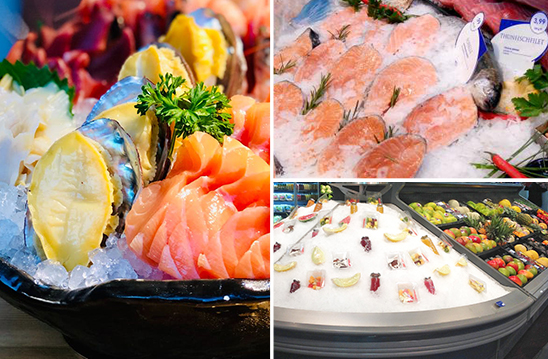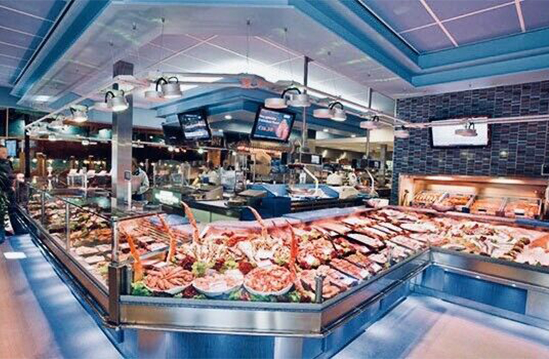
Ideal ice temperature of -0,5°C:

Food presentation
We have the right solution for your supermarket display
Made in Germany:
What ice should be used for your goods displays?
The selection of the correct type of ice is of vital importance in the presentation of fresh goods such as fish and sea food.
Required amount of ice
In the first step, you should calculate the amount of ice you need for your display.
Storage and ice transport
In the morning, a large amount of ice must be available for the ice bed of the display.
The costs
The total annual costs for the ice in your ice display comprise the following items:
Capacity and operating temperatures
The production capacity of an ice machine depends heavily on the surrounding and water temperatures.
Food presentation with the perfect ice
ZIEGRA ice machines: Ice for your store displays.
Ideal ice temperature -0,5°C:
Automatic solutions
Food presentation:
Made in Germany:
What ice should be used for your goods displays?
The selection of the correct type of ice is of vital importance in the presentation of fresh goods such as fish and sea food.
It depends on the goods:
The ice makes sure:
The ice therefore must have a range of characteristics:
Do not forget: you have to create a new ice bed each morning. That means: the main amount of ice must be available in the morning; it is therefore produced overnight and stored in a bin. It is therefore particularly important, that the ice does not freeze together in storage.
Both chip ice and flake ice are regularly used for goods displays in supermarkets. Chip ice, however, has more of the required characteristics: with its temperature of -0.5°C and the different possible grains it combines storability, softness, mouldability and long durability. In addition the appearance of chip ice is excellent for product presentations.
Required amount of ice
In the first stage you should calculate the amount of ice that you need for your display. Here the surface of the display and the desired height of the ice are decisive (normally: 10-15 cm). To the right you will find a calculator which will help you determine the correct ice machine for your ice requirements.
The total of the calculator gives you the choice between ice production on 1 or 2 machines (standard or double) as well as, where possible, a choice between the 20° and 35°C version (explanation).
It takes into account the fact that the ice is recreated every day and a certain amount is needed for re-freezing and for the fish storage overnight.
Storage and ice transportation
In the morning a large amount of ice has to be available for the ice bed of the display. In order to achieve this, the machine should produce ice at day and night, which has to be stored in a suitable bin (or ice cart).
In order to guarantee the quality of the ice after longer storage, the storage capabilities should be observed.
Due to the ideal temperature of -0.5° C, chip ice can also be stored for a longer period of time without freezing together. Scale ice on the other hand, freezes together over a long period of time. As a result a larger machine is required, which produces the same amount of ice in the shortest possible time.
Every morning the ice has to get to the display. The more ice is needed, the more attention should be paid to ice transportation. Contact us, we will be happy to advise you.
Important points for the selection of the correct storage and transportation solution are:
Heat emission and cooling
Ice machines produce heat, which is emitted via the condenser.
The following options can be considered for this:
Positioning of the ice machine
The following points have to be clarified before making a decision on the positioning:
Avoid installing your ice machine in a refrigerator room, as it emits heat which warms the room. This also applied to the ice maker with a separate condenser. In a refrigerator room, even one with a temperature above 0°C, the room condenser emits cooled-air below 0°C. If this air comes into contact with the ice machine or the ice output then the ice machine can freeze, which can cause production losses and defects to the machine.
The costs
The total annual costs for the ice in your ice display comprise the following items:
The potential for cost reductions on the operating costs, with a share of 40% of the annual overall costs, is particularly high. With suitable ice distribution systems you could even save up to 50 or even 75%. Due to the working time this would save with the ice bed, your employees would be able to concentrate fully on the design of the goods presentation.
Capacity and operating temperatures
The production capacity of an ice machine depends heavily on the surrounding and water temperatures.
Each machine has a nominal output for certain, stated temperatures. Consequently the output is sometimes stated at a surrounding and water temperature of 10° C, sometimes at 20°C / 15°C or even at 35°C / 25°C.
The higher the nominal temperatures of the ice machine, the more powerful it is.
Compared to the nominal temperatures, the ice output is reduced by approx.:
Example:
An ice machine with 1,000 kg/24h produces the following amount at a surrounding temperature of 35°C and a water temperature of 25°C:
1.000 kg, if the nominal output is stated at 35° surrounding / 25° water
700-800 kg, if the nominal output is stated at 20° surrounding / 15° water
500-600 kg, if the nominal output is stated at 10° surrounding / 10° water
In addition to this the ice quality reduces considerably above the nominal temperatures. The ice becomes watery, slushy and melts very quickly.
When selecting your ice machine make sure that the nominal temperatures of the surrounding temperatures correspond to those in the warmest period of the year. This is because at this time your requirement of good quality ice is at its greatest.
Hygiene
The hygienic quality of the ice should correspond to the water used. Increasing bacteriological checks by vets guarantee the hygienic standard in the supermarket industry.
Our ice machines are suitable for this.
The following rules have to be observed by the user:
Replacing the ice
For hygienic and optical reasons, the ice should be exchanged daily. The evening is the best time for this, so that a fresh bed of ice is available the following morning.
Here are a few recommendations on removing ice from the display: